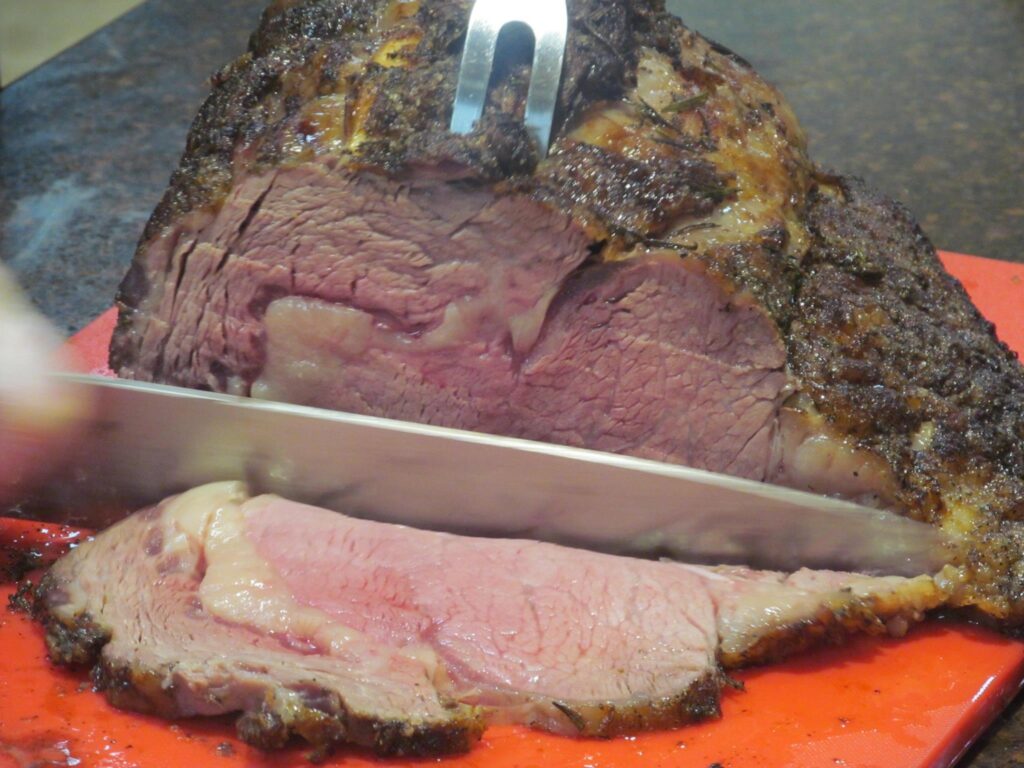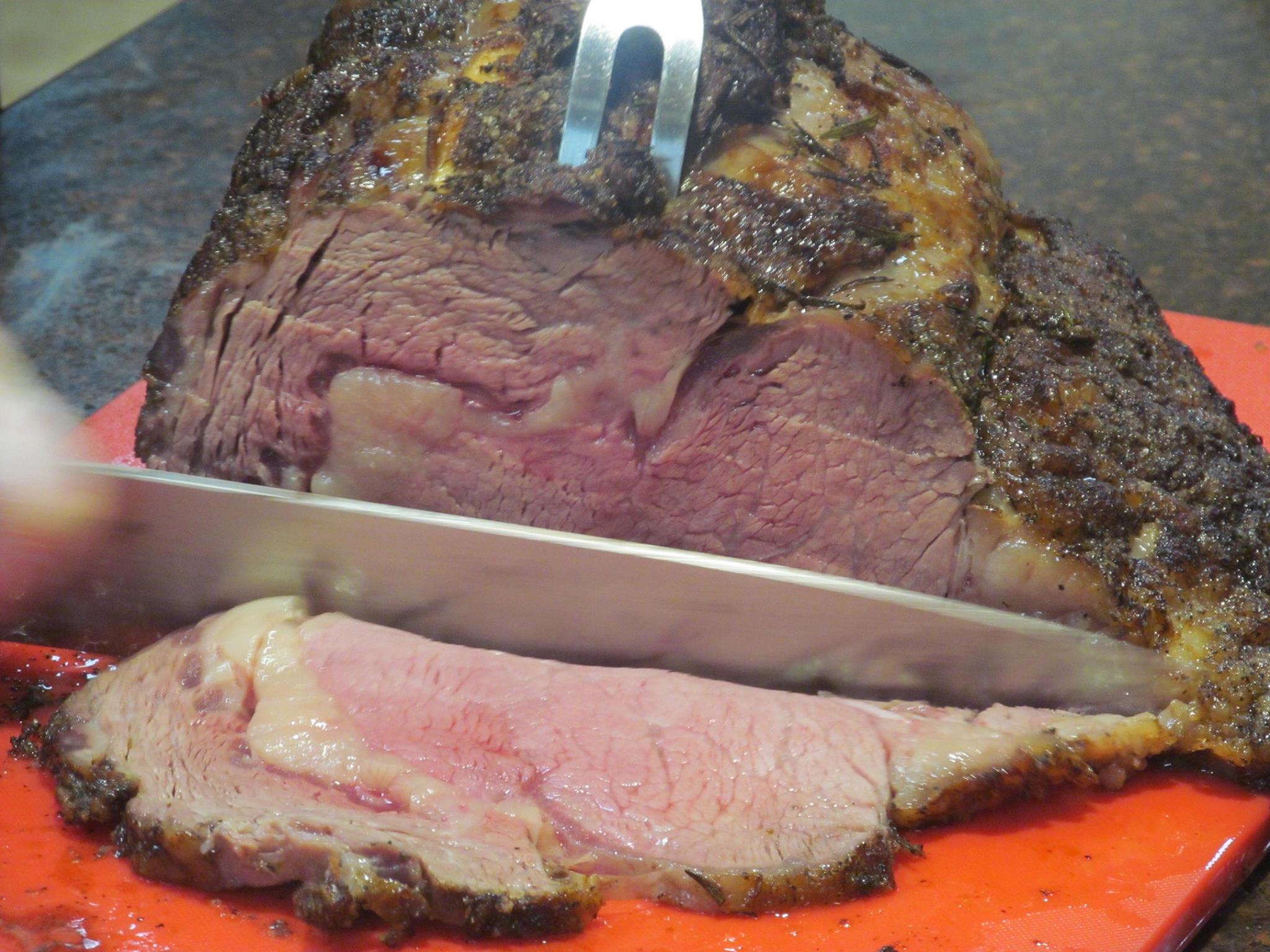
It is the holiday season and it’s time to decide what your main course is going to be. Some people choose tenderloin, some choose striploin, but the most popular holiday roast is the standing rib roast that is better known as the Prime Rib.
The prime rib not only has a tremendous amount of mouth watering flavor due to the amount of fat throughout but it also is a very forgiving roast to cook. The prime rib has a center known as the eye which is the dense inner most piece of the prime rib. The eye is surrounded by the Spinalis Dorsi, better known as the deckle, and even better known as the ribeye cap. The ribeye cap is tender beyond belief and even if you overcook the roast it will remain tender, moist, and flavorful due to the amount of fat it holds. This ribeye cap will protect the eye (center of the roast) from overcooking and it is the unsung hero of holiday roasts.
If you decide to purchase a bone-in roast there are a couple of things to discuss. First, the bone doesn’t actually add any flavor. It will add to the weight of your roast and you will end up paying a bit extra just for bones. HOWEVER, for bone lovers it is an essential part of the roast. Not only can you set the bones, bone side down when cooking instead of using an oven rack but having the bones to chew on and marrow to suck at is a delicacy that can’t be overlooked.
A great way to utilize the bones is to have your butcher remove the bones and then tie them back on. It will help when it comes time to carve the roast but it also makes it so that after the roast is done you can continue to cook the bones until the marrow and the meat melts off the bone and is extremely tender. Just an option, but definitely worth exploring.
Cooking a prime rib roast is pretty easy. The morning of the cook you will want to remove the roast from the refrigerator first thing to allow it time to approach room temperature. It speeds up the cooking process but also prevents the outside from cooking faster than the center.
Generously season the roast with salt and pepper, at the very least. Granulated garlic, onion salt, or any herbs and spices you love on beef will work great just be sure to go a bit heavy. Keep in mind you are only able to season the outer edge of the beef, the center won’t be seasoned at all. An au jus, gravy, or cream sauce will help with that but make sure your outside crust is flavorful. Use olive oil to rub the roast down, this can be done before or after you season, there are benefits to both. Place your rosemary and thyme on the roast, if your roast is tied just tuck them under the twine. Spread them out evenly across the top.
If you haven’t already set your oven to 250 degrees Fahrenheit. Cooking at a low temperature may take longer but it will be the reason your roast has the same color and temperature from edge to center. High oven temperatures will cook the edge faster than the center and it will make the outer edge gray and well done. Keep that in mind for any large roasts.
Place the roast bones side down in a thick bottom roasting pan and place the roast into the oven. If you have a leave in meat thermometer, it will help out greatly; you can insert it now. It is worth the price to know exactly what your roast is at all times and most have a timer/alarm to let you know when your roast is finished.
Cook the roast until the internal temperature at the thickest part of the roast is 122-125 degrees Fahrenheit. All ovens are different unfortunately, but an accurate oven will typically take about 2-2.5 hours to cook.
Remove the roast from the oven, remove the thyme and rosemary from the roast.
Set the oven to broil or its highest setting. Once it is up to temp place the roast back into the oven for 10-15 minutes or until there is a nice crust on the outside of the roast. It is important to keep the roast temperature from surpassing 134 degrees if you want a rare-medium rare roast.
Remove the prime rib from the oven and lest rest for 20 minutes. Resting meat allows the muscle fibers to relax and redistribute the juices back throughout the meat, it is the most important part of cooking beef. If you slice/carve your beef immediately the juices will run out of the roast and it will taste dry. Resting your meat also allows the beef to finish cooking. After being in the heat for so long the roast will continue to rise in temperature, which is know as residual heat. Residual heat will raise the temperature of the roast from 5-10 degrees, and in very large roasts all the way up to 15 degrees.
MAKE SURE YOU LET THE ROAST REST!
Place the roast onto a cutting board, remove the twine, and remove the bones whether they were removed and tied back on or not. Slice the bones between each bone. You can slice your roast into any thickness you desire but keep in mind this is a premium cut of beef and if you slice it too thin it won’t look as impressive. Aim for 1/2″ to 1″ slices. Any sharp knife will do for slicing a roast, a good serrated knife, a carving knife, and a butcher knife have always worked great.
Arrange your slices neatly on a serving platter and top with more rosemary and thyme. Rosemary and thyme are aromatics and just being on and around the roast will lend its flavor.
Enjoy watching everyone’s face as they love every single bite!

Bone-In Prime Rib
Ingredients
- 10 lb Bone-In Prime Rib Bone Removed and Tied Back On
- 1 tbsp Granulated Garlic
- 3 sprigs Fresh Thyme
- 2 sprigs Fresh Rosemary
- Olive Oil Enough to Coat All Surfaces
- Salt and Pepper Enough to Generously Coat All Surfaces
Instructions
- Let your meat sit out for a few hours to let it approach room temperature.
- Preheat oven to 250 degrees.
- Generously season your roast with salt, pepper, and granulated garlic then rub the entire roast with oil. Separate the sprigs of thyme and rosemary and lay them over the roast.
- Place the roast bones side down in a roasting pan and place in the oven.
- Cook the roast until the internal temperature is 116 degrees where the meat is thickest. Remove the roast from the oven and set the oven to broil. Remove thyme and rosemary from the roast and set aside.
- Once the oven is up to temperature and the meat has been allowed to rest for 10 minutes, place the prime rib back in the oven and cook for an additional 10 minutes or until there is a nice crust on the outside of the roast (no longer than 15). Do not let the roast internal temperature surpass 125 degrees.
- Remove the roast, cover it with foil, and let rest for 20 minutes.
- Carve and serve.
Notes
The lower your oven temperature while cooking the more uniform your color will be from top to bottom. For example, if you cooked the entire roast at a high temperature the outsides will be over cooked while the middle will be just right.
Purchase a meat thermometer that can stay in the roast throughout the cooking process, so you don’t have to keep checking the roast.
After slicing your roast, take the rosemary and thyme and rub it on each slice of meat.
